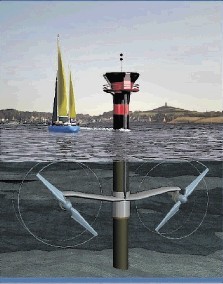
A PhD researcher at UHI says that tidal turbulence may pose a risk to the siting and operation of tidal energy devices in Scotland’s Pentland Firth.
The so-called “kolk boils” can be seen from cliff tops, ferry decks and aerial photographs taken at the right state of the tide. Commercial fishermen in the area have intimate knowledge of the phenomenon.
Similar phenomena can be seen in other locations, like the Corryvreckan between the islands of Jura and Scarba on the West Coast.
The risk presented by these distinctive features was identified by Juvénal Dufaur during his doctoral studies at the Environmental Research Institute (ERI) in Thurso.
During fieldwork, Juvénal noticed that turbulent phenomena appear with differing intensities depending upon the location and state of the tide. He also identified that they evolve along the line of the flow with variable lifetimes.
Now working part-time at Thurso-based consultancy Caithness Renewables, he has secured funding from the UK Natural Environment Research Council (NERC) to undertake a more detailed study of the these features in the Pentland Firth.
The funding provided through NERC’s Marine Renewable Energy Internship programme aims to provide marine developers with a better understanding of the tidal flow and potential risks.
According to Juvénal, extraction of energy from the tides is considered to be a straightforward process when the flow is smooth and exceeds 1.5-2 metres per second.
However, very fast flows, such as those within the Pentland Firth tidal stream, generate turbulence of a kind that could compromise projects.
Through a collaboration between the ERI and industry, Caithness Renewables Ltd will provide a de-risking study for tidal project developers. While focussed in the Pentland Firth the work may find applications in other areas of the world earmarked for potential tidal energy development.
Recommended for you
